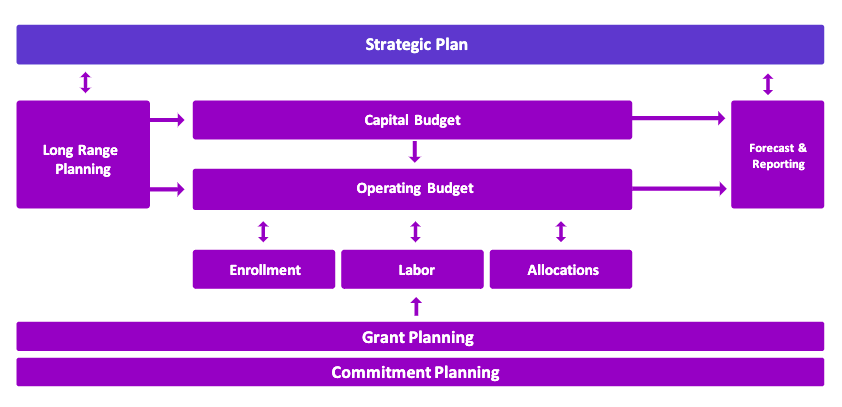As you think about the higher education landscape over the past few years, it’s easy to blame the COVID-19 pandemic for the challenges felt across campuses. But COVID only amplified the pre-existing pressures on colleges and universities, including revenue challenges — most notably declining enrollment — rising costs, disruptive competition, and new strategic imperatives such as the renewed focus and concern about college accessibility.
Pressure Rising, Finance Teams Evolving
Asked about upcoming enrollment challenges, 51% of finance professionals1 cited the “demographic cliff” as the top concern that will have the greatest financial impact on their institutions over the next 5-10 years. The cliff refers to a projected drop in potential first-time, full-time freshmen due to a significant drop in children born during and after the 2008 financial crisis.
At many institutions, finance teams continue trying to navigate such issues using inadequate analytics and outdated or ill-equipped financial planning tools, such as spreadsheets. However, colleges and universities with more future-focused finance processes have leaders who rise to meet a broad range of evolving expectations for their roles. For many, that means becoming digital and business transformation leaders, data experts at both the big picture and granular levels, and trusted advisors who can help guide the institution forward.
An institution’s long-term success hinges on the ability to skillfully plan for the future while remaining agile — yet 84% of college and university finance leaders believe their organizations don’t do enough to leverage financial and operational data to make decisions.2 But what does it look like to use this data to improve planning and agility today and in the long-term?
Think Ahead: An Integrated Plan for the Future
Looking to the future, higher education leaders should balance the need to manage near-term priorities with long-term planning. Striking this balance is vital to preparing for future challenges while also making the most of current and emerging opportunities.
As you think about the long-term plan for your college or university, ask yourself the following questions:
- What goals are you trying to achieve?
- Who should be involved in the process?
- Who are your stakeholders?
- What format and outputs do your stakeholders require?
- How does the long-range plan relate to other planning processes?
Consider the diagram below as the desired future state, one in which previously disparate data and planning processes are integrated to drive more informed decision-making. Breaking down the strategic plan into a long-range financial model ensures you incorporate your P&L, balance sheet, cash flows, comparisons for Moody’s and S&P ratings, and various scenarios to determine if your institution can ultimately afford its strategic plan.
Long-Range Planning in Action at UNT System
If you’re currently feeling the pain of an Excel-based planning model, know that there is a better way. The University of North Texas (UNT) System used to rely on a complex, time-consuming, and Excel-based long-range planning process, further complicated by dependence on a single employee’s Excel skills. Running different scenarios was a cumbersome, error-prone process that took days.
The wish list for a new long-range planning solution at UNT System was threefold: easy to use, transparent, and integrated financial planning. “We wanted to blur the boundaries between our budget, our accounting structure, our annual financial reports, and our strategic plan,” says Kerry Romine, Senior Director of Business Planning and Strategy. “We wanted a more integrated financial process overall.”
After implementing Syntellis’ Axiom™ Long-Range Planning, UNT System can now run scenarios in minutes, easily show profit-and-loss impact on new initiatives, and power a truly integrated financial planning structure that effectively and efficiently manages the institution’s limited resources.
“With Axiom Long-Range Planning, we’ve grown what we can do as an institution. In the past, we might have made decisions that were ill-informed. Now we don’t have to worry about that because we make decisions based on data that we can stand behind,” said Romine.
Future-Proof Your Institution with Axiom
In an industry likely to continue to feel financial pressure for years to come, future-proofing your institution means ensuring you have the right tools to enhance strategic decision-making, perform robust scenario modeling, and integrate planning processes.
Axiom Long-Range Planning provides powerful financial modeling, reporting, and analytics tools that help colleges and universities develop mid- and long-range financial plans that are stress tested and aligned to their institution’s strategic plan.
1https://www.syntellis.com/resources/report/cfo-outlook-higher-education-planning-uncertainty. Syntellis Performance Solutions, 2022.
2Ibid.
Learn more about long-range planning with Axiom

Improve Financial Planning to Future-Proof Your Institution

Scenario Modeling Helps Higher Education Finance Leaders Plan Confidently



